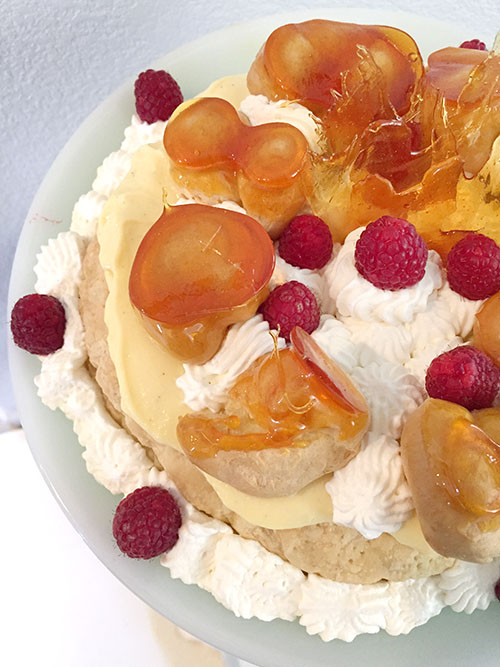 “…there is nothing either good or bad, but thinking makes it so.â€
“…there is nothing either good or bad, but thinking makes it so.â€
— William Shakespeare
[I]t’s ironic that each year, I make a birthday cake for myself (but mainly for my blog, since we share birthdays). Because, to be honest, on the list of desserts I favor, cake ranks low. I am more a crisp, cobbler, pudding or pie kind of gal. And my favorite dessert of all — a simple baked custard (see blog entry of 2/14), is so humble and comforting and uncakelike. But cakes, more than any other sweet finale, say special occasion. They say celebration. They say honor or tribute.
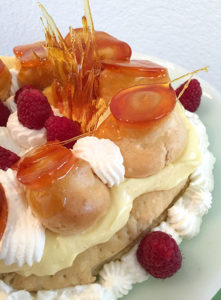 So imagine my delight when, about a year or more ago, I stumbled across a cake that was not so much a traditional cake of the batter-and-frosting variety, but a cake assembled of puff pastry, custard-y cream, whipped cream and, gasp, cream puffs! And the capper was, it was a “cake†created by the French to honor the patron saint of pastry chefs.
So imagine my delight when, about a year or more ago, I stumbled across a cake that was not so much a traditional cake of the batter-and-frosting variety, but a cake assembled of puff pastry, custard-y cream, whipped cream and, gasp, cream puffs! And the capper was, it was a “cake†created by the French to honor the patron saint of pastry chefs.
The Gateau St. Honore seemed the perfect and fitting tribute for the birthday of a blog and blogger primarily devoted to baking. Still, as I pondered the impending production of said cake, it seemed an arduous project. Many steps and processes. Over the years, I’ve documented the extensive work (and whining) I’ve put into my annual cake tradition, attempting to get just right the just right cake. I’ve joked about “building†a birthday cake each year, but this one truly meant that, gauging the assemblage. Frankly, I was tired of all the work it might be even before I hot started.
 Sometimes perception or thought outweighs the actuality or reality of the thing. Take aging, for example. Each year, my gaze goes both inward and into scopes far beyond my reality. I am star-gazing at too much big-picture thinking of life, the whole of life, the downhill and dwindling of life (hold on, it won’t be too much more of the depressing). What I’ve discovered about life is, it’s full of surprises, sometimes bad ones, yes, but good ones, too. The reality is sometimes BETTER than what you imagined it to be.
Sometimes perception or thought outweighs the actuality or reality of the thing. Take aging, for example. Each year, my gaze goes both inward and into scopes far beyond my reality. I am star-gazing at too much big-picture thinking of life, the whole of life, the downhill and dwindling of life (hold on, it won’t be too much more of the depressing). What I’ve discovered about life is, it’s full of surprises, sometimes bad ones, yes, but good ones, too. The reality is sometimes BETTER than what you imagined it to be.
Sometimes we need to be open and not prejudge or predefine. What I have thought would happen to me as I have gotten older is what everyone thinks will happen to them as they get older, certain decline and giving up. This has not happened, and in fact I have been pleasantly surprised. You can continue to surprise yourself, folks, in good ways. You have only to try. What a number (or name) says is not always the idea of the number. It is the reality of the number, and it’s up to you to decide what that will be.
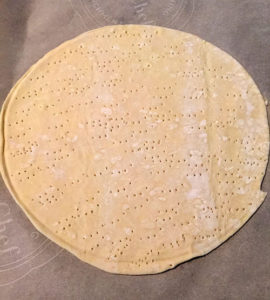 It’s up to you to decide what a cake will be. So what is a cake? The average thought of the average human is: Frosting so sugary it will curl your lips, bitter candy rosebuds, layers of bland, crumbly cake. Chocolate, chocolate, chocolate? Or, could it be a confection designed as a lighted crown?
It’s up to you to decide what a cake will be. So what is a cake? The average thought of the average human is: Frosting so sugary it will curl your lips, bitter candy rosebuds, layers of bland, crumbly cake. Chocolate, chocolate, chocolate? Or, could it be a confection designed as a lighted crown?
Would the St. Honore cake really be an arduous process — as the idea of it seemed…or was it, like life itself, as easy as our approach and attitude toward it.
I watched a video of a pro baker putting a St. Honore together, and it suddenly seemed as if it might be one of the easier birthday cakes I’d ever attempted. If I allowed myself enough time, took the 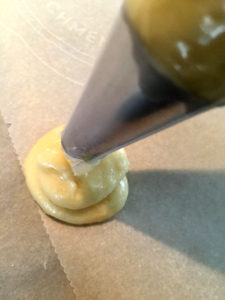 steps in approachable stages, and kept a semi-cheery and adventurous outlook, I’d be fine. I made my pastry cream a day earlier to allow it plenty of chill time. I took the shortcut (suggested in the video) of making my cake base from pre-packaged puff pastry, rolled out and cut into a circle to be baked off.
steps in approachable stages, and kept a semi-cheery and adventurous outlook, I’d be fine. I made my pastry cream a day earlier to allow it plenty of chill time. I took the shortcut (suggested in the video) of making my cake base from pre-packaged puff pastry, rolled out and cut into a circle to be baked off.
Then, the cream puffs. Having recently made gougeres (see blog entry of 8/16), I had been reminded what a snap and a near magical miracle pate a choux is. So my egg-y batter was piped into tiny puffs to be baked, then filled.
Then caramelized! I had also lately been dabbling in clear caramel (more on that to come), and had learned its charms and secrets (one tip: whisk cream of tarter into sugar before adding water and cooking the caramel to prevent crystals from forming).
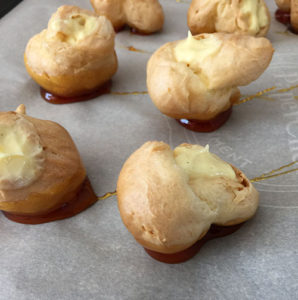 Assembling the cake was really simpler than frosting one (not my strong uit). After spreading pastry cream across the airy disk of puff pastry, I “crowned†it with the caramel glazed puffs. I had made some sweetened whipped cream (another learned tip: add a little dry milk powder to cream before whipping to help stabilize it). Feeling daring, I used an actual pastry bag and decorated the cake more with fancy “sworls†of the cream. A few plump raspberries added a hint of color.
Assembling the cake was really simpler than frosting one (not my strong uit). After spreading pastry cream across the airy disk of puff pastry, I “crowned†it with the caramel glazed puffs. I had made some sweetened whipped cream (another learned tip: add a little dry milk powder to cream before whipping to help stabilize it). Feeling daring, I used an actual pastry bag and decorated the cake more with fancy “sworls†of the cream. A few plump raspberries added a hint of color.
The cake was beautiful, a daunting French pastry I had doubted I was capable of making and there it was, no tears shed and really little sweat. I had beginner’s luck again, which fits, because I always feel like I’m still beginning, even now. Are things really hard or do we often make them so? The caramel on the puffs shone like little lights to guide my way.
Even so, I lit a candle.
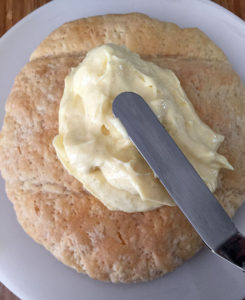
Gateau St. Honore
Adapted from recipe by Anna Olson
Makes 1 9-inch torte 
Serves 10-12
1 sheet rolled puff pastry, thawed in the fridge
Pastry Cream 
1 cup 2% milk

½ vanilla bean or 1 ½ tsp vanilla bean paste
3 large egg yolks 

3 tablespoons sugar

2 tablespoons cornstarch

2 tablespoons unsalted butter, cut into pieces
Profiteroles

½ recipe choux paste (recipe follows)
3 tablespoons water

1 cup sugar 

1 tablespoon white corn syrup
Assembly

1 ½ cups whipping cream
1 ½ tablespoon skim milk powder 

3 tablespoons sugar 

1 teaspoon vanilla extract 

Preheat the oven to 375 oF and line a baking tray with parchment paper.
Cut the puff pastry into a 9-inch circle (or use the shell from a 9-inch removable tart pan to cut a circle with a pretty fluted edge) and place this on the baking tray. Dock the pastry with a fork and bake for about 20 to 25 minutes until an even golden brown. Cool.
Heat the milk with the scraped seeds of the vanilla bean or the vanilla bean paste until just below a simmer.
In a separate bowl, whisk the egg yolks, sugar and cornstarch. Ready a bowl with the butter, placing a strainer on top of it.
Gradually whisk the hot milk into egg mixture and then return it all to the pot. Whisk this constantly (switching to a spatula now and again, to get into the corners) over medium heat until thickened and glossy, about 2 minutes. Pour this immediately through the strainer, whisking it through if needed, and stir in the butter. Place a piece of plastic wrap directly over the surface of the custard, cool to room temperature and then chill completely until ready to use.
For the profiteroles, preheat the oven to 400 F and line two baking trays with parchment paper.
Fill a piping bag fitted with a large plain tip with the choux paste. Pipe profiteroles, each about 1 ½ -inches across. Wet your finger in cool water and tap any points on the batter. You will need 16 to 18 profiteroles for the torte.
Bake the profiteroles for 10 minutes, then reduce the heat to 375 degrees F and continue to bake for about 15 more minutes, until they are a rich golden brown color and are very light. Allow the pastries to cool completely before filling.
To fill, stir the pastry cream to soften and fill a piping bag with a medium plain tip (or an éclair or doughnut tip, if you have one). Use a skewer to first poke a small hole in the side of each profiterole. Insert the piping bag and fill each with cream until you feel resistance. Save any remaining pastry cream for the torte. Chill until ready to dip in caramelized sugar.
Bring the water, sugar and corn syrup up to a boil in a small pot over high heat and continue to boil, uncovered and without stirring, and occasionally brushing the sides of the pot with water, until it is a light amber color. Ready a bowl of ice water and carefully set the bottom of the pot into the ice water to halt the sugar from cooking further.
Using tongs, carefully dip the tops of the profiteroles halfway into the caramelized sugar and place them, caramel side down, on a lightly greased parchment-lined baking tray to set. If the caramel in the pot begins to set before you have finished, you can reheat the caramel on low heat.
To assemble, whip the cream and skim milk powder until it holds a soft peak and stir in the sugar and vanilla. Divide the cream in half, stir the raspberry puree into one half and then fill 2 piping bags fitted with a plain or star tip each with a cream.
Place the baked puff pastry disc onto the serving plate. Spread the remaining pastry cream on the bottom, leaving a half inch space around the outside edge. Arrange the dipped profiteroles on top of the puff pastry, creating a ring around the outside and so that the flat, caramel-dipped tops are facing up. Pipe with whipped cream and chill until ready to serve.
Basic Choux Paste
¾ cup 2% milk

¾ cup water

½ cup + 2 tablespoons unsalted butter 

2 teaspoons sugar

½ teaspoon salt 

1 2/3 cups all-purpose flour, sifted 
5 large eggs, at room temperature
Bring the milk, water, butter, sugar and salt up to a full simmer over medium high heat. Reduce the heat to low and stir in the flour with a wooden spoon, stirring vigorously until the dough “cleans†the sides of the pot (no longer sticks). Scrape this mixture into a large bowl and use electric beaters or a stand mixer fitted with the paddle attachment and beat on medium speed for a minute or two to cool it a little.
Break two eggs into a small dish and whisk them just to blend a little. Add these to the flour mixture while still on medium speed and mix until blended. Add the remaining 3 eggs one at a time and mixing well after each addition.
Work with this recipe while the batter is still warm.